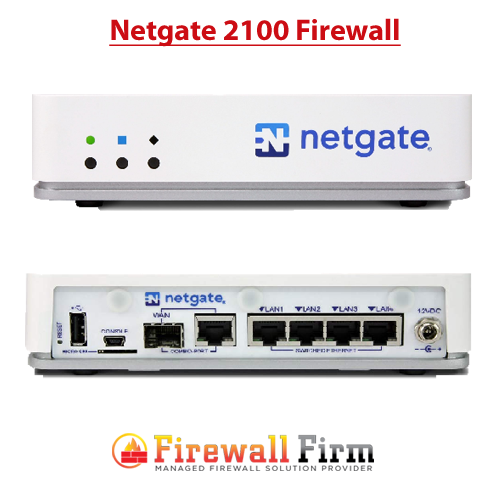Netgate 2100 Firewall
Buy Netgate Firewall online from Firewall Firm’s IT Monteur Store
| Netgate 2100 Firewall | Register & Request Quote | |||||||||||||||||||
 |
|
Netgate 2100 Firewall | ||||||||||||||||||
The Netgate 2100 delivers unbeatable performance and flexibility in its class. Perfect for home, remote workers, and small business deployments that require more resources for multiple add-on packages and VPN performance.
- Cost efficient / Low power
- Sleek, compact
- Silent operation (fanless)
- Put on a desktop, shelf, or wall
- Upgradeable Storage
Who is this for?
- Home
- Home Pro
- Branch/Small Business
Opening the Way to High Performance
The standing joke with software development has been “Good, cheap, fast – pick any two.” That has certainly been the case with carrier-class, high performance networking. No more. Open networking technology is changing the game. Telecom and cloud service providers can have all three – while at the same time transforming their networks to achieve greater agility and flexibility.
As an example, who would have thought it possible to see a 100 Gbit/s software router running on commercial-off-the-shelf (COTS) hardware just a few years ago? And why does it matter? Service providers are under constant pressure to provide greater bandwidth at lower latency under increasingly demanding traffic conditions – especially owing to modern application design and encrypted transport. But are service providers ready to exploit the power of open networking for the most demanding consumer and business subscriber applications? How aware are they of the latest packet processing advancements? Do they believe it is commercially viable? Are we ready for a wholesale shift from proprietary to open-source infrastructure? If not, what’s holding us back? These questions were designed to provide insight. Here is what we learned. Service providers are highly confident that open source networking solutions can deliver on high performance. Performance and acceleration gains are needed at every layer of service provider architecture – from the customer premises to the network core. In fact, most are already using open networking technologies to address high-performance networking requirements – for production and internal networking needs But there remains work to be done.
The biggest impediment to faster adoption of open networking solutions is not performance, but rather technology
immaturity. And that could be rooted in a lack of use-case familiarity, confidence in testing and verification, or the fact that many high-performance open networking projects are still relatively new. Nonetheless, the appeal of high performance, open-source networking solutions vs. closed-source, vendor proprietary alternatives is irresistible.
Respondents point directly to cost savings, freedom from vendor lock-in, faster innovation, and ease of integration into existing IT infrastructure as the driving forces for adoption. And this is true across networking (routing, load balancing, traffic inspection) and security (firewall, IDS/IPS, traffic inspection) functions. It is also clear that familiarity with core building blocks for a pervasive open networking infrastructure is not high across the board. While technologies related to containerization are recognized by more than 50% of the respondents, data plane and orchestration terms (e.g., VPP, FRR, DPDK, RESTCONF and Smart NICs) are significantly less well-known Perhaps the most interesting finding of all is that while cost savings is usually the obvious pull for open-source adoption,
that isn’t necessarily the case with high performance networking and acceleration. Almost half of the respondents said they would consider high-performance open networking if it is at least price-competitive with mainstream proprietary alternatives – given the freedom and flexibility it affords.
These are exciting times for open networking initiatives across the board for service provider adoption. As technology awareness and maturity continue to make headway, service providers are positioned to enjoy “good, cheap, and fast.”
AUTOMATION
Automating operations is critical to CSPs’ goal of improving efficiency and lowering opex. Disaggregated open networking solutions more easily integrate with automation tools such as Ansible, and are therefore an important element in CSP transformation. Methodologies like DevOps, where the same team is responsible for the development and ongoing support for applications, and Continuous Integration/Continuous Development (CI/CD) will also play a role, as technology alone will not be sufficient if the processes around them don’t change as well. While virtualizing network functions is a critical first step in CSP transformation, the true benefit will come when their lifecycle is automated. Containers and PaaS platforms loom on the horizon as additional tools to further CSPs’ automation goals.
 Firewall Training in India Cyber Security Training & Firewall Training Provider in India
Firewall Training in India Cyber Security Training & Firewall Training Provider in India











